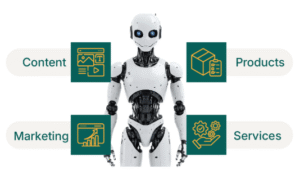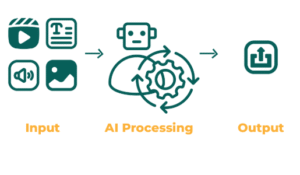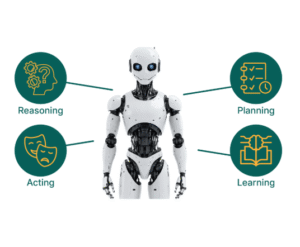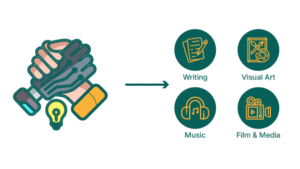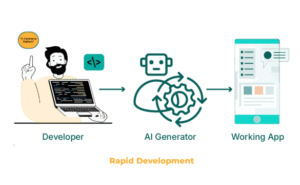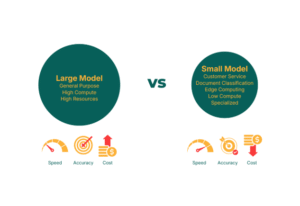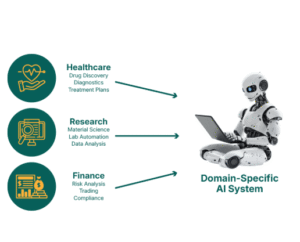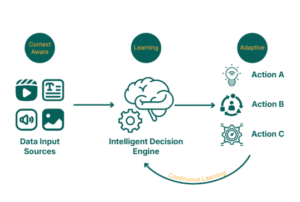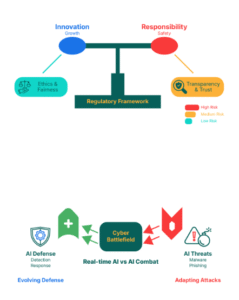Ever feel like AI is evolving faster than you can keep up? You’re not alone. The artificial intelligence landscape in 2025 is moving at breakneck speed, and what seemed like science fiction just a year ago is now transforming how we work, create, and live our daily lives.
From AI that knows your preferences better than your closest friends to autonomous digital workers handling complex business tasks, these aren’t just cool tech demos anymore—they’re real tools making real impact across every industry you can imagine.
We’ve dived deep into the latest industry insights to bring you the ten most game-changing generative AI trends of 2025. Whether you’re a business leader trying to stay competitive, a developer looking for the next big thing, or just someone curious about where technology is heading, this guide will help you understand what’s happening and why it matters.
1. Hyper-Personalization: AI That Knows You Better Than You Know Yourself
Think your Netflix recommendations are good? That’s nothing compared to what’s coming. Hyper-personalization is taking AI beyond simple “people who bought this also bought that” suggestions to create experiences that feel almost telepathic.
This isn’t your typical demographic targeting or even behavioral segmentation. We’re talking about AI that understands you as an individual—your communication style, your mood patterns, even your unspoken preferences. It’s like having a personal assistant who’s been watching your every move (in a helpful, not creepy way) and can anticipate what you need before you even know you need it.
Here’s what makes hyper-personalization so powerful:
- Real-time adaptation: Content, products, and experiences change based on your current context
- Cross-platform intelligence: Your preferences follow you seamlessly across all touchpoints
- Predictive personalization: AI anticipates your future needs based on patterns and trends
- Micro-moment optimization: Every interaction is tailored to your specific situation and mindset
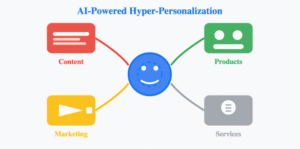
Generative AI creates individually tailored experiences across content, products, marketing, and services, with each user at the center of their personalized ecosystem.
Imagine logging into a streaming service where the AI doesn’t just recommend different movies—it creates personalized trailers featuring the exact scenes and music that appeal to your taste. Or visiting an e-commerce site where product descriptions are rewritten in your preferred communication style, and the entire layout adapts to how you like to shop.
Real-world applications that are happening right now:
- Dynamic content creation: News articles rewritten for your reading level and interests
- Personalized user interfaces: App layouts that change based on your usage patterns
- Contextual recommendations: Suggestions that factor in time of day, weather, and your schedule
- Adaptive pricing and offers: Deals tailored to your budget and purchase history
The engagement rates speak for themselves—companies using hyper-personalization are seeing 20-30% increases in conversion rates because customers feel like the technology actually “gets” them.
2. Advanced Multimodal AI: Breaking Down the Barriers Between Senses
Remember when you had to use separate apps for editing photos, transcribing audio, and analyzing documents? Those days are quickly becoming history. Advanced multimodal AI is creating systems that can seamlessly understand and work with text, images, audio, video, and even 3D data all at once.
Think about how you naturally communicate with friends—you might show them a photo, describe something verbally, and gesture with your hands all in the same conversation. That’s exactly what multimodal AI enables, but with artificial intelligence that can process all these different types of information simultaneously and understand the connections between them.
What makes this technology so groundbreaking:
- Cross-modal understanding: AI that sees relationships between different types of data
- Context preservation: Information flows seamlessly between visual, audio, and text processing
- Natural interaction: Communicate with AI the way you naturally communicate with humans
- Unified intelligence: No more switching between different AI tools for different tasks
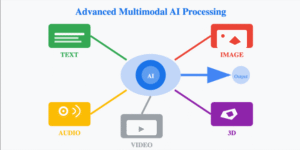
Modern AI systems seamlessly integrate multiple input types—text, images, audio, video, and 3D data—creating unified, context-rich understanding and responses.
Picture this: You’re working on a presentation and you upload a rough video of yourself explaining an idea, along with some sketches and a few bullet points. A multimodal AI system can watch your video, understand your sketches, read your notes, and then create a polished presentation that captures your exact intent—complete with refined visuals and speaker notes that match your speaking style.
Game-changing applications already emerging:
- Universal content creation: One AI system that handles all aspects of content production
- Enhanced accessibility: Automatic conversion between different formats for diverse needs
- Intuitive interfaces: Interact with technology using whatever combination of inputs feels natural
- Comprehensive analysis: AI that can analyze a business problem using documents, meetings, and visual data simultaneously
This technology is particularly exciting for education, where students can learn in whatever way works best for them, and for business, where complex problems often require analyzing information from multiple sources and formats.
3. Agentic AI: The Rise of Autonomous Digital Workers
Here’s where things get really interesting. Agentic AI isn’t just about having AI tools that respond to your commands—we’re talking about AI systems that can set their own goals, make plans, and take actions independently. Think of them as digital employees who don’t just wait for assignments but actively identify problems and solve them.
The breakthrough here is autonomy. Instead of you telling the AI exactly what to do step-by-step, you give it an objective, and it figures out how to achieve it. It’s like the difference between hiring someone to follow a detailed manual versus hiring an expert who understands the big picture and can adapt their approach as circumstances change.
What makes agentic AI systems so powerful:
- Independent reasoning: Can analyze complex situations and develop strategies
- Goal-oriented behavior: Works toward objectives rather than just executing commands
- Adaptive planning: Adjusts approach based on changing circumstances and new information
- Continuous learning: Gets better at tasks through experience and feedback
- Multi-step execution: Handles complex workflows that span hours, days, or even weeks
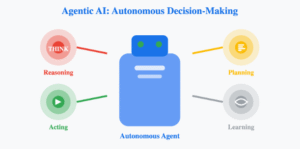
Agentic AI systems combine reasoning, planning, acting, and learning capabilities to function as independent digital workers capable of complex autonomous decision-making.
Imagine giving an AI agent the goal of “improve customer satisfaction” and watching it analyze support tickets, identify common issues, develop solutions, implement process changes, and even coordinate with other systems—all while you focus on strategic decisions. That’s the power of agentic AI.
Real-world applications transforming businesses:
- Customer service management: AI agents that proactively identify and resolve service issues
- Supply chain optimization: Systems that anticipate disruptions and automatically adjust logistics
- Content strategy execution: AI that plans, creates, and publishes content across multiple channels
- Financial portfolio management: Agents that monitor markets and execute trades based on your investment goals
The key difference from traditional automation? These systems don’t just follow rules—they understand context, adapt to new situations, and get better at their jobs over time. It’s like having a team member who never sleeps and continuously improves their performance.
4. AI-Powered Creativity: When Machines Become Muses
Let’s address the elephant in the room: “Is AI going to replace human creativity?” The answer is nuanced, but based on what we’re seeing in 2025, AI is becoming less of a replacement and more of an incredibly powerful creative partner. Think of it as having a collaborator who brings infinite patience, vast knowledge, and the ability to explore thousands of variations instantly.
The magic happens when human creativity meets AI capability. You bring the vision, emotion, and purpose—AI brings speed, iteration power, and fresh perspectives you might never have considered. It’s like having a creative team that never gets tired and can explore “what if” scenarios at lightning speed.
How AI is amplifying human creativity:
- Infinite iteration: Explore countless variations of your ideas without fatigue
- Cross-domain inspiration: AI draws connections between different creative fields
- Technical skill amplification: Focus on creativity while AI handles technical execution
- Overcoming creative blocks: AI suggests directions when you’re stuck
- Democratized creation: Anyone can now create professional-quality content
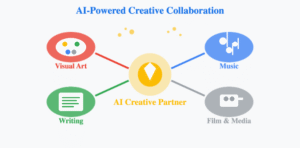
Generative AI serves as a creative collaborator across visual art, music, writing, and film, enhancing human creativity by providing new perspectives and infinite iterations.
Take music production, for example. A songwriter can hum a melody, and AI can instantly generate full orchestral arrangements, suggest chord progressions, or even create variations in different musical styles. A novelist can describe a scene, and AI can help visualize it, suggest plot twists, or even help with world-building details. The human brings the emotional core and creative vision—AI amplifies the execution.
Creative breakthroughs happening right now:
- Collaborative storytelling: Writers and AI co-creating narratives in real-time
- Dynamic art generation: Visual artists using AI to explore styles and concepts rapidly
- Music composition partnerships: Musicians collaborating with AI for arrangement and production
- Film and video creation: Directors using AI for storyboarding, editing, and even generating scenes
- Cross-media creativity: Stories that span books, games, and videos created collaboratively
The most exciting part? AI democratizes creativity. You don’t need years of technical training to create a movie trailer, compose a song, or design a professional-looking website. The barriers between having creative ideas and bringing them to life are disappearing fast.
5. Generative Code & App Builders: Programming at the Speed of Thought
Remember when building an app required months of coding, debugging, and testing? Those days are rapidly becoming history. Generative code and app builders are transforming software development from a highly technical craft into something much more accessible and intuitive.
The real game-changer isn’t just that AI can write code faster—it’s that it can understand intent and translate business problems directly into working solutions. You describe what you want your app to do, and AI figures out how to make it happen, handling everything from architecture decisions to user interface design.
What’s revolutionizing software development:
- Natural language programming: Describe your app in plain English, get working code
- Instant prototyping: Turn ideas into testable applications in minutes, not months
- Automatic optimization: AI writes efficient, well-structured code following best practices
- Smart debugging: AI identifies and fixes issues before you even notice them
- Cross-platform deployment: One description creates apps for web, mobile, and desktop
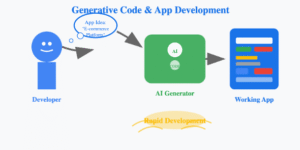
AI-powered development tools transform ideas into functional applications rapidly, enabling both developers and non-programmers to create software at unprecedented speed.
This isn’t just autocomplete on steroids—we’re talking about AI that understands software architecture, user experience principles, and business logic. It can take a conversation about your business needs and turn it into a fully functional application complete with database design, user authentication, and responsive design.
Who’s benefiting from this revolution:
- Non-technical entrepreneurs: Turn business ideas into working prototypes without hiring developers
- Domain experts: Teachers, doctors, and other professionals creating specialized tools for their fields
- Experienced developers: Focus on complex problem-solving while AI handles routine coding
- Startups and small businesses: Build sophisticated applications without large development teams
- Enterprise teams: Rapidly prototype and test new solutions before major investments
The democratization aspect is huge. A marketing manager can now build custom analytics dashboards, a teacher can create interactive learning apps, and a restaurant owner can develop a custom ordering system—all without writing a single line of traditional code.
But here’s the interesting part: experienced developers aren’t becoming obsolete. Instead, they’re becoming more like architects and creative problem-solvers, working with AI to tackle bigger, more complex challenges than ever before.
6. Small & Efficient Models: Proof That Size Isn’t Everything
While everyone’s been obsessing over bigger and bigger AI models, a quiet revolution has been happening in the opposite direction. Small and efficient AI models are proving that sometimes, focused intelligence beats raw computational power. It’s like the difference between using a massive Swiss Army knife for every task versus having the perfect specialized tool for each job.
These compact models challenge the “bigger is always better” assumption that has dominated AI development. Instead of trying to be good at everything, they excel at specific tasks while using a fraction of the computational resources of their massive counterparts.
Why small models are making a big impact:
- Cost-effective deployment: Run sophisticated AI on regular hardware instead of expensive servers
- Real-time performance: Instant responses instead of waiting for cloud processing
- Privacy protection: Process sensitive data locally without sending it to external servers
- Edge computing: AI that works in smartphones, cars, and IoT devices
- Specialized excellence: Often outperform large models on specific tasks
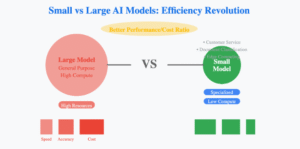
Compact AI models deliver specialized performance with dramatically lower computational costs, proving that efficiency and focus often outperform raw size and general capability.
Think about it this way: do you really need a massive AI model that can write poetry, analyze images, and solve math problems just to classify customer support tickets? A focused, lightweight model can often do that specific job better, faster, and much more cost-effectively.
Real-world advantages driving adoption:
- Mobile AI applications: Sophisticated AI features in smartphones without draining battery
- IoT and edge devices: Smart home devices that work without internet connectivity
- Real-time applications: AI-powered features that respond instantly without server delays
- Cost-conscious deployments: Small businesses can afford advanced AI capabilities
- Privacy-sensitive applications: Medical, financial, and personal data processed locally
This trend is particularly exciting because it makes AI accessible to organizations that couldn’t afford massive cloud computing bills. A small restaurant can use AI for inventory management, a local clinic can implement AI-powered diagnostic assistance, and a startup can add intelligent features without venture capital funding.
The lesson? Sometimes the most powerful solution isn’t the biggest one—it’s the one that’s perfectly suited for the job at hand.
7. Industry-Specific AI: Precision Tools for Specialized Challenges
Generic AI tools are like generic medications—they might help a little with many problems, but they’re not optimized for any specific condition. Industry-specific AI, on the other hand, is like having a specialist doctor who understands exactly what you’re dealing with and has the precise tools and knowledge to help.
These aren’t just general AI systems with a fresh coat of industry-themed paint. We’re talking about AI that deeply understands domain-specific terminology, regulations, workflows, and challenges. It’s the difference between having a general assistant and having a colleague who’s been working in your field for decades.
What makes industry-specific AI so powerful:
- Domain expertise: Deep understanding of industry terminology, processes, and challenges
- Regulatory compliance: Built-in knowledge of industry-specific laws and requirements
- Specialized workflows: Designed around how professionals actually work
- Industry benchmarks: Performance measured against relevant standards and metrics
- Ecosystem integration: Works seamlessly with existing industry-standard tools and platforms
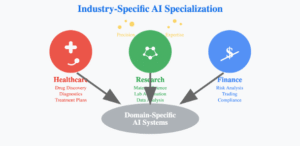
Specialized AI systems tailored for specific industries deliver unprecedented accuracy and insights in healthcare, research, and finance applications.
In healthcare, for example, AI doesn’t just analyze medical images—it understands the difference between normal anatomical variations and potential pathologies, knows which follow-up tests to recommend, and can factor in patient history and current medications. It speaks the language of medicine fluently.
Transformative applications across industries:
- Healthcare & Life Sciences:
-
-
- Drug discovery acceleration – AI that understands molecular interactions and predicts promising compounds
- Diagnostic assistance – Image analysis that matches specialist-level accuracy for specific conditions
- Personalized treatment plans – Recommendations based on genetic profiles, medical history, and latest research
-
- Financial Services:
-
-
- Risk assessment – Models that understand market dynamics and regulatory requirements
- Fraud detection – Systems trained on financial crime patterns and compliance rules
- Algorithmic trading – AI that adapts to market conditions while managing regulatory constraints
-
- Scientific Research:
-
- Lab automation – AI that understands experimental protocols and can adapt to new conditions
- Literature analysis – Systems that can read and synthesize thousands of research papers
- Hypothesis generation – AI that suggests novel research directions based on existing knowledge
The key difference? These systems don’t just process data—they understand context, implications, and the nuanced requirements of professional practice. It’s like having a domain expert who never gets tired and can process vast amounts of information instantly.
8. Intelligent Process Automation: Beyond Simple Task Automation
Traditional automation was like programming a very sophisticated robot to follow a detailed instruction manual. Intelligent process automation is like hiring a knowledgeable colleague who understands the goals and can adapt their approach based on changing circumstances. It’s the evolution from “do exactly this” to “figure out the best way to achieve this outcome.“
The breakthrough isn’t just in speed or accuracy—it’s in the AI’s ability to understand context, make judgment calls, and continuously improve its approach. This isn’t your grandfather’s assembly line automation; it’s dynamic, adaptive, and genuinely intelligent.
What makes intelligent process automation revolutionary:
- Context-aware decision making: Understands the bigger picture, not just individual tasks
- Exception handling: Adapts to unexpected situations without human intervention
- Continuous optimization: Gets better at processes over time through learning
- Cross-system integration: Orchestrates complex workflows across multiple platforms
- Predictive problem-solving: Identifies and addresses issues before they become problems
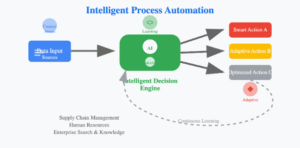
Intelligent process automation uses AI to make complex decisions and adapt workflows dynamically, going far beyond simple rule-based automation with context-aware, learning-capable systems.
Instead of simply following predefined rules, these systems can evaluate situations, consider multiple factors, and choose the best course of action. They learn from every interaction and continuously optimize their performance.
Game-changing applications transforming business operations:
- Supply Chain Management:
-
-
- Predictive inventory optimization – Anticipates demand changes and adjusts procurement automatically
- Supplier relationship management – Evaluates vendor performance and negotiates better terms
- Logistics coordination – Dynamically routes shipments based on real-time conditions
-
- Human Resources:
-
-
- Intelligent candidate screening – Evaluates resumes and interviews with nuanced understanding
- Employee development planning – Creates personalized career paths and learning recommendations
- Performance optimization – Identifies productivity barriers and suggests improvements
-
- Enterprise Knowledge Management:
-
- Intelligent document routing – Automatically directs information to relevant stakeholders
- Knowledge synthesis – Combines information from multiple sources to answer complex questions
- Compliance monitoring – Ensures processes adhere to regulations without manual oversight
The real power comes from the AI’s ability to handle edge cases and exceptions—the situations that traditional automation couldn’t handle. When an unusual situation arises, instead of breaking down or requiring human intervention, intelligent process automation adapts and finds solutions.
9. AI Governance, Ethics & Regulation: Building Trust in the AI Future
Here’s the thing about AI regulation—it’s not about slowing down innovation; it’s about building the foundation for sustainable, trustworthy AI development. Think of it like traffic laws: they don’t exist to prevent driving, but to ensure everyone can drive safely and efficiently.
The regulatory landscape in 2025 is maturing rapidly, with frameworks like the EU AI Act leading the way. These aren’t one-size-fits-all approaches—they’re sophisticated, risk-based systems that apply different levels of oversight depending on how AI is being used and what the potential impact could be.
Key principles shaping AI governance:
- Risk-based regulation: Higher oversight for high-impact applications, lighter touch for low-risk uses
- Transparency requirements: Clear disclosure when AI is making decisions that affect people
- Algorithmic accountability: Systems for auditing and explaining AI decision-making processes
- Privacy protection: Ensuring personal data is handled responsibly in AI training and deployment
- Human oversight: Maintaining meaningful human control over critical AI systems
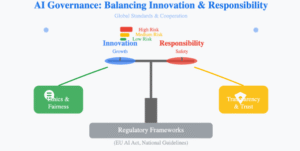
AI governance balances innovation with responsibility, establishing frameworks for ethics, transparency, and trust while supporting continued technological advancement.
The sophistication of current regulatory approaches is actually encouraging innovation by providing clear guidelines. Companies know what’s expected of them, which makes it easier to build compliant systems from the ground up rather than retrofitting compliance later.
How regulation is shaping AI development:
- Risk-Based Categorization:
-
-
- Minimal risk (AI in games) – Basic transparency requirements
- Limited risk (chatbots) – Clear disclosure of AI interaction
- High risk (hiring, lending, healthcare) – Strict oversight and human review requirements
- Unacceptable risk (social scoring, subliminal manipulation) – Banned entirely
-
- Global Coordination Efforts:
-
- International standards development – Creating common frameworks across countries
- Cross-border enforcement cooperation – Coordinating regulatory actions
- Industry self-regulation initiatives – Companies proactively adopting best practices
- Academic and civil society involvement – Multi-stakeholder approaches to governance
The goal isn’t to create barriers to innovation—it’s to ensure that as AI becomes more powerful and pervasive, it develops in ways that benefit society and respect human rights. Companies that embrace this approach early are finding it gives them a competitive advantage in markets where trust and reliability matter.
10. Cybersecurity: The AI Arms Race in Digital Defense
Welcome to the most intense technology arms race of our time. In cybersecurity, we’re seeing AI systems literally battling each other in real-time, with attackers and defenders using increasingly sophisticated artificial intelligence to gain advantage. It’s like a chess match where both players are grandmasters and every move happens in milliseconds.
This isn’t just about faster detection or response—we’re witnessing a fundamental transformation in the nature of cybersecurity. AI is enabling both more sophisticated attacks and more effective defenses, creating a dynamic where the pace of innovation on both sides is accelerating rapidly.
The dual nature of AI in cybersecurity:
- AI-Powered Defense:
-
-
- Real-time threat analysis – Processing millions of events per second to identify anomalies
- Predictive security – Anticipating attack vectors before they’re exploited
- Automated response – Neutralizing threats faster than human response times
- Adaptive protection – Security systems that evolve based on new attack patterns
-
- AI-Enhanced Attacks:
-
- Intelligent malware – Code that adapts to evade detection systems
- Deepfake social engineering – Convincing fake audio and video for phishing attacks
- Automated vulnerability discovery – AI that finds security weaknesses faster than defenders can patch them
- Personalized phishing – Highly targeted attacks based on AI analysis of social media and public data
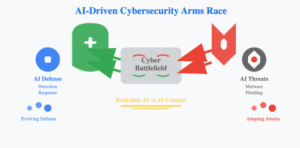
AI powers both cyber attacks and defenses, creating an escalating arms race where artificial intelligence systems battle each other in real-time digital warfare.
What makes this particularly intense is the speed and scale of modern AI-driven cybersecurity. We’re seeing attack and defense cycles that happen in milliseconds, with both sides continuously adapting their strategies based on what the other is doing.
The escalating cycle of AI cyber warfare:
- Defensive Innovations:
-
-
- Behavioral analysis – AI that learns normal network patterns and spots anomalies
- Zero-day prediction – Systems that identify potential vulnerabilities before they’re exploited
- Automated patch deployment – Rapid response to new threats across entire networks
- Threat intelligence synthesis – AI that combines global threat data for better protection
-
- Offensive Evolutions:
-
- Polymorphic attacks – Malware that constantly changes to evade detection
- AI-generated phishing – Highly convincing fake communications tailored to specific targets
- Living-off-the-land techniques – Using legitimate tools in malicious ways to avoid detection
- Supply chain infiltration – Sophisticated attacks on software development and distribution
The stakes couldn’t be higher. As our digital infrastructure becomes more critical to daily life, the battle between AI-powered attacks and defenses becomes a matter of national security, economic stability, and personal privacy.
The organizations winning this arms race are those that view cybersecurity not as a static defense system, but as a dynamic, learning ecosystem that evolves as quickly as the threats it faces.
The Road Ahead: What These Trends Mean for Your Future
So where does all this leave us? We’re standing at a fascinating inflection point where AI is transitioning from an interesting technology to an integral part of how we work, create, and solve problems. These ten trends aren’t happening in isolation—they’re interconnected forces that are reshaping entire industries and creating entirely new possibilities.
For business leaders and organizations:
- The message is clear: the companies that will thrive in the next decade are those that view AI not as a replacement for human capabilities, but as an amplifier that makes their people more creative, productive, and effective. The democratization happening through small models and generative development tools means that competitive advantage increasingly comes from how quickly you can adapt and implement new solutions.
Key strategic considerations:
- Start with problems, not technology: Identify real business challenges before choosing AI solutions
- Invest in AI literacy: Ensure your team understands both capabilities and limitations
- Plan for governance: Build ethical AI practices into your processes from the beginning
- Embrace experimentation: The pace of change means you need to test and learn continuously
For individuals and professionals:
Whether you’re a developer, creative professional, business analyst, or in any other field, the future belongs to those who can effectively collaborate with AI systems. This doesn’t mean you need to become a machine learning expert, but you do need to understand how to leverage these tools to amplify your unique human capabilities.
Skills that will matter most:
- Critical thinking and problem framing: AI can generate solutions, but humans need to define the right problems
- Creative collaboration: Working with AI as a creative partner rather than just a tool
- Ethical reasoning: Understanding the implications and responsibilities that come with AI-powered decisions
- Adaptive learning: Continuously updating skills as AI capabilities evolve
The bigger picture:
Perhaps most importantly, these trends point toward a future where the barriers between having an idea and implementing it continue to shrink. AI is democratizing capabilities that were once limited to specialists and large organizations. A small team with the right AI tools can now accomplish what previously required entire departments.
But with great power comes great responsibility. As AI becomes more capable and pervasive, the decisions we make about how to develop, deploy, and govern these systems will shape society for generations. The trends we’re seeing in 2025—from agentic AI to industry-specific applications to regulatory frameworks—are laying the groundwork for a future where AI serves as a force for positive transformation.
The key is to remain thoughtfully optimistic: embracing the incredible possibilities while staying grounded in human values and ethical considerations. The future of AI isn’t predetermined—it’s being shaped by the choices we make today about how to build, regulate, and use these powerful technologies.
What you can do now:
- Stay curious: Experiment with AI tools in your field to understand their capabilities
- Think ethically: Consider the broader implications of AI applications in your work
- Collaborate thoughtfully: Use AI to enhance rather than replace human judgment and creativity
- Keep learning: The AI landscape evolves rapidly, so continuous learning is essential
The ten trends we’ve explored aren’t just technological developments—they’re the building blocks of a future where human creativity and artificial intelligence work together to solve problems we couldn’t tackle alone. That future is being built right now, and you have a role to play in shaping it.
